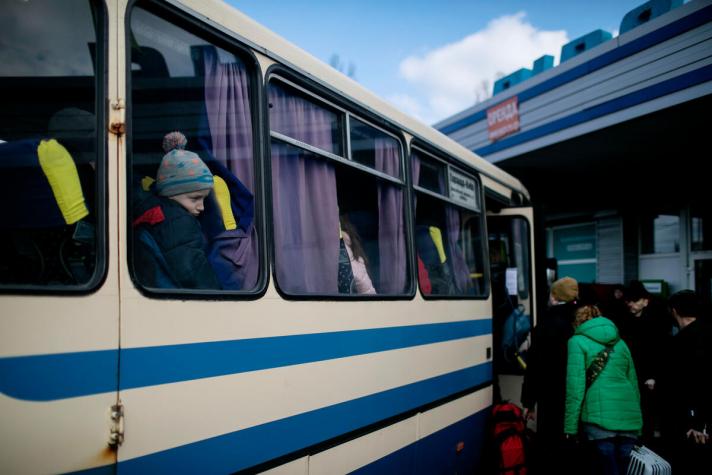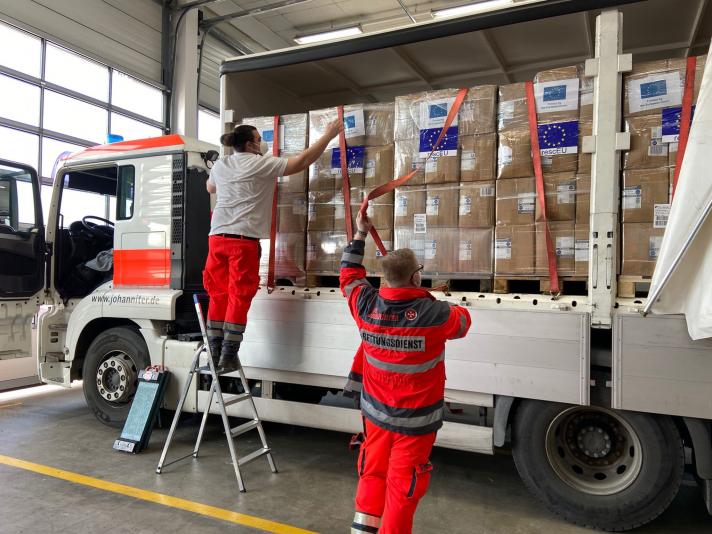Russia’s war in Ukraine amounts to a humanitarian catastrophe not seen in decades in Europe. Since the invasion started, over 2 million people have fled to neighbouring countries for safety.
Those who stay are suffering enormously. They are hiding in shelters from missiles falling from the sky. Thousands of civilian casualties have already been reported, and vital civilian infrastructure is heavily damaged.
The EU, together with its partners, supports Ukraine with emergency assistance, both humanitarian aid and civil protection.
How is the EU helping now, given the current humanitarian situation?
The EU is providing both humanitarian aid and civil protection assistance to Ukraine and neighbouring Moldova, Poland and Slovakia as people fleeing the war continue to arrive.
Following Russia’s invasion, the UN High Commissioner for Human Rights (OHCHR) recorded 1,123 civilian casualties in Ukraine, of which 364 were killed. Real figures are probably considerably higher.
On 1 March, Commission President Ursula Von der Leyen announced at least €500 million in EU funding for response activities dealing with the humanitarian consequences of the crisis.
This includes €90 million in initial support for our humanitarian partners on the ground to alleviate the suffering of people in need in Ukraine and those who fled to neighbouring countries, particularly Moldova.
This new funding will help people inside Ukraine and those who have fled to neighbouring countries by providing food, water, health care, shelter, protection and help to cover their basic needs.
“Ensuring humanitarian access, including through the establishment of humanitarian corridors, is an urgent priority right now as to enable the delivery of humanitarian aid to people in need caught in the ongoing war in Ukraine," said Commissioner for Crisis Management, Janez Lenarčič.
"It is imperative that civilians are protected, and humanitarian workers can do their jobs in safety and without impediments, as obliged by international humanitarian law,” he explained.
The needs are growing by the day. This is why our Emergency Response Coordination Centre (ERCC) is working 24/7 to monitor the situation in the country and respond to requests for assistance from Ukraine and neighbouring countries.
What material assistance are you deploying?
EU countries have offered medical supplies and equipment, ambulances, beds, tents, generators, and other much-needed emergency relief items via the EU Civil Protection Mechanism to Ukraine and neighbouring countries hosting Ukrainian refugees.
“The Ukrainian authorities tell us what they need most urgently in terms of emergency assistance. These needs are communicated to the participating states of the EU Civil Protection Mechanism,” explains Jürgen Schreiber, who is leading the Civil Protection Team in Poland.
“When we get offers for assistance, we make sure they get here as quickly as possible, and in a coordinated manner. We work closely with the Polish authorities. Then, they are loaded on trucks and trains headed for Ukraine and dispatched to the places where they are most needed,” says Schreiber.
“Personally, I am impressed by the outpour of solidarity that we have been seeing here in Poland and countries all over the world,” he adds.
Moldova activated the EU Civil Protection Mechanism on 24 February, asking for assistance to accommodate refugees fleeing Ukraine, while Slovakia did the same on 27 February.
Poland has also activated the EU Civil Protection Mechanism on 28 February, requesting medical items and medicines.
So far, 26 EU countries (Belgium, Bulgaria, Czechia, Denmark, Germany, Estonia, Ireland, Greece, Spain, France, Croatia, Italy, Cyprus, Latvia, Lithuania, Luxembourg, Malta, Netherlands, Austria, Poland, Portugal, Romania, Slovenia, Slovakia, Finland, and Sweden) have already offered support.
In addition, Norway has also contributed as a participating state to the EU Civil Protection Mechanism.
How do you make sure the assistance reaches Ukraine
and its neighbouring countries?
The European Commission has established logistical civil protection hubs in Poland, Romania and Slovakia. These hubs are channelling the assistance delivered from European countries via the EU Civil Protection Mechanism in response to the requests for assistance by Ukraine and neighbouring countries.
In addition, the EU is also deploying further assistance via the rescEU medical stockpiles based in Germany, Hungary and the Netherlands. This support includes ventilators, infusion pumps, patient monitors, masks and gowns, ultrasound devices and oxygen concentrators.
The EU stands ready to provide further emergency assistance to Ukraine and those forced to flee their homes in cooperation with neighbouring countries.
When did the EU start to provide emergency aid to Ukraine?
On 15 February, following a request for assistance by the Government of Ukraine, the Commission started coordinating the delivery of essential supplies via the EU Civil Protection Mechanism. Aid was swiftly deployed to support Ukraine’s preparedness for all possible scenarios, with the threat of further escalation.
Since 2014, the EU and its Member States have supported Ukraine with over €1 billion in humanitarian aid and early recovery aid. We have funded projects covering cash assistance, health care, protection activities, shelter, water, psychosocial support, and education in emergencies, among other intervention areas.
In the past years, we have provided humanitarian assistance in eastern Ukraine - both along the line of contact and in the areas not controlled by the Ukrainian government. This also includes assistance for Ukrainians having fled to Russia.
Story by Jaime Camacho Garcia with contributions from Lisa Hastert, EU Civil Protection and Humanitarian Aid Operations.
Publication date: 08/03/2022



